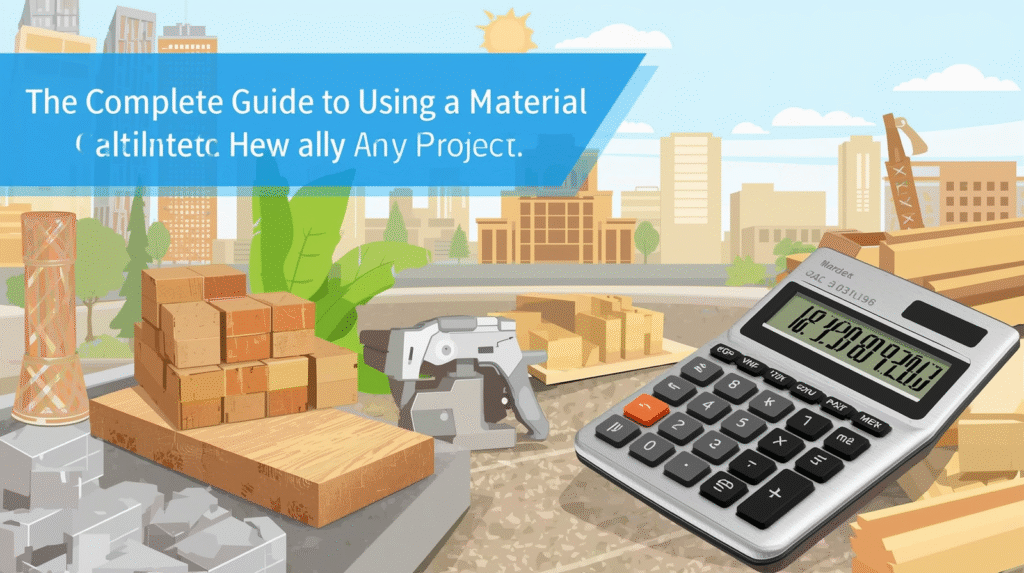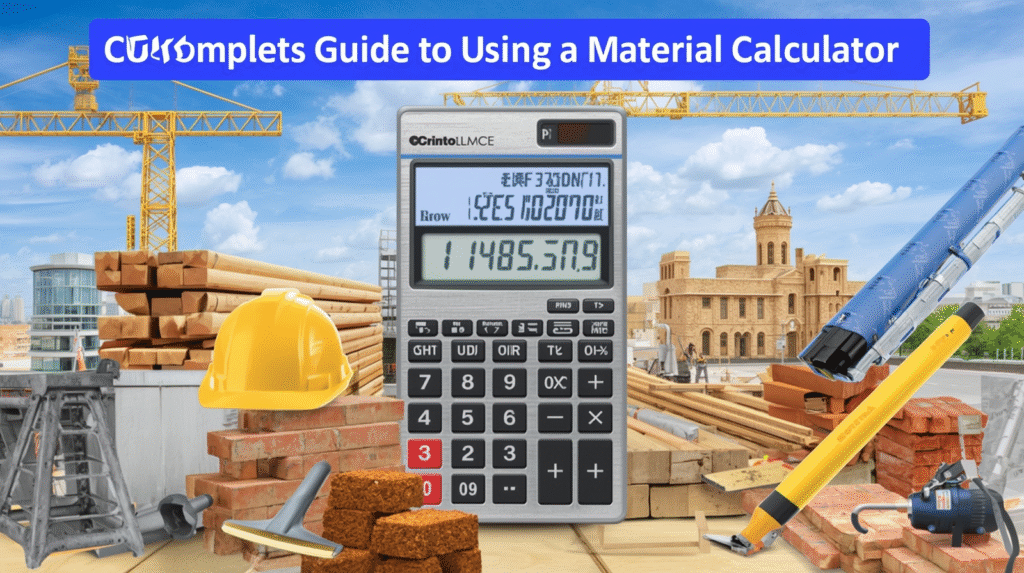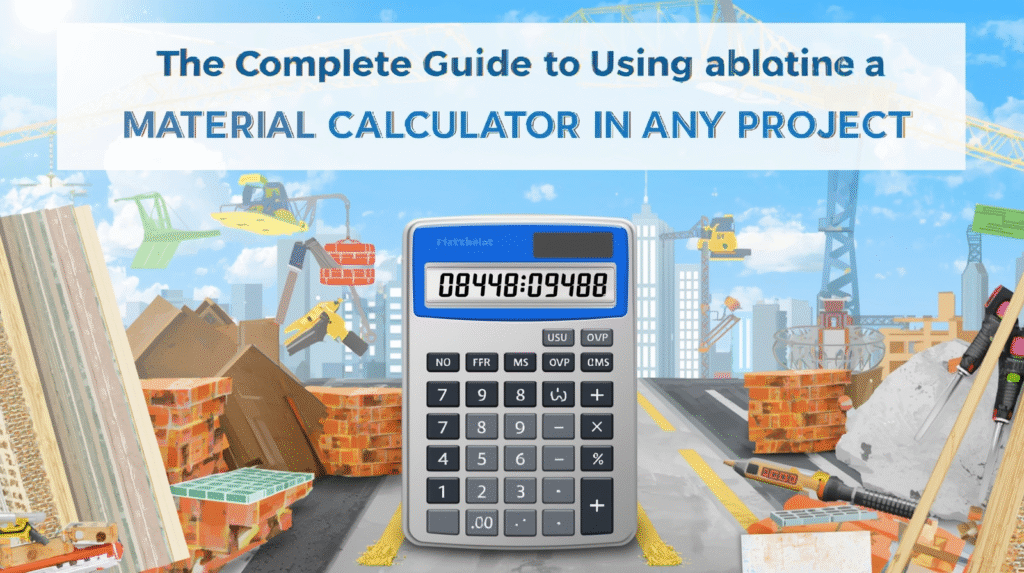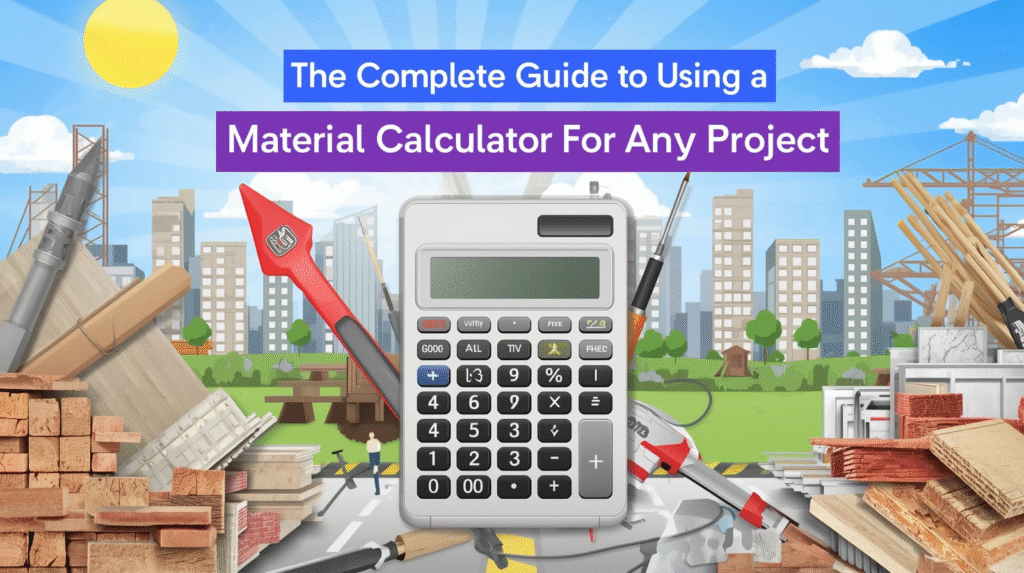Have you ever started a home project and realized halfway through that you bought too much—or not enough—material? It happens to almost everyone. Whether you’re building a deck, pouring concrete, or laying tiles, guessing how much material you need can lead to wasted money and time. That’s where a material calculator comes in.
A material calculator is a simple but powerful online tool that helps you figure out exactly how much material your project needs. It uses your measurements, area, or volume to estimate the right amount of concrete, wood, gravel, paint, or any other material. In this guide, you’ll learn how these calculators work, why they’re so useful, and how to use them correctly. Let’s dive in!
Table of Contents
1. What Is a Material Calculator?

A material calculator is an online or app-based tool that helps you estimate the quantity of materials needed for a project. You enter basic measurements—like length, width, depth, or area—and the calculator gives you the total amount required.
For example, if you’re building a patio, you can use a material calculator to find out how many bags of concrete you’ll need. Or if you’re painting a wall, it can help you estimate how many gallons of paint to buy. This tool takes the math out of the equation, saving you time and reducing the chance of costly mistakes.
2. Why You Should Always Use a Material Calculator
Using a material calculator is not just convenient—it’s smart. Many people either overestimate or underestimate what they need. Overbuying means spending more money than necessary, while underbuying can delay your project when you run out of supplies.
A calculator helps you plan efficiently and budget better. It also supports sustainability since you avoid wasting excess materials. For DIY projects, small renovations, or large construction jobs, using a material calculator ensures accuracy from the start. It’s like having a math expert sitting next to you, guiding every step.
3. How Does a Material Calculator Work?

Most material calculators use basic geometry to determine volume or area. You just enter the shape, size, and sometimes the material density. The calculator then applies simple formulas to estimate how much you’ll need.
For example:
- Concrete: length × width × depth = cubic yards
- Paint: wall area ÷ coverage per gallon = gallons needed
- Gravel: cubic feet ÷ 27 = cubic yards
Some calculators even let you adjust for material loss or compaction, giving a more realistic estimate. You don’t have to know any formulas—the material calculator does all the math for you.
4. Different Types of Material Calculators

There’s no one-size-fits-all version. Depending on your project, you can find calculators for:
- Concrete – for slabs, footings, and driveways
- Gravel and sand – for landscaping and driveways
- Paint – for walls, ceilings, and trim
- Tile and flooring – for rooms or patios
- Lumber and decking – for carpentry projects
Each material calculator is tailored to specific materials and shapes. Using the right one helps you get precise results for your unique project needs.
5. Real-Life Example: Using a Material Calculator for Concrete
Let’s say you’re pouring a small backyard patio that’s 10 feet long, 10 feet wide, and 4 inches deep. That equals 0.33 feet of depth. A material calculator will multiply 10 × 10 × 0.33 = 33 cubic feet.
Since concrete is sold in cubic yards, you divide by 27. The answer is about 1.22 cubic yards. The calculator might then recommend 1.5 cubic yards to account for spillage and uneven ground. That’s how simple and accurate a material calculator can be—it takes the guesswork out of your project.
6. How to Use a Material Calculator Step-by-Step
Here’s how to use one effectively:
- Choose the right calculator for your project (concrete, paint, gravel, etc.).
- Measure your space accurately. Use a tape measure for precise results.
- Enter your dimensions into the calculator.
- Adjust for extra material (usually 5–10% more).
- Review the result and note how much to buy.
It only takes a few minutes, but it can save hours of frustration later. With a material calculator, planning becomes simple, fast, and stress-free.
7. Benefits of Using a Material Calculator
Here are the biggest benefits:
- Saves money: You buy only what you need.
- Saves time: No more last-minute store runs.
- Improves accuracy: No human errors in math.
- Helps with planning: Know your total cost upfront.
- Reduces waste: You’re being environmentally responsible.
Every builder, contractor, or DIY enthusiast can benefit from using a material calculator. It’s a small step that brings big results.
8. Common Mistakes People Make Without a Calculator
Without a material calculator, it’s easy to misjudge how much to buy. People often round numbers or forget to include small spaces like corners or edges. They might also skip adjusting for waste or material loss.
For instance, using exact measurements for tile without adding extra for cutting or mistakes could leave you short by a few pieces. Using a material calculator helps prevent those small but costly errors.
9. Top Online Material Calculators to Try
There are many free tools available online. Some reliable options include:
- Calculator.net – Simple and covers multiple materials.
- Inch Calculator – Great for construction and landscaping.
- Lowes & Home Depot – Offer easy calculators for customers.
- ConcreteNetwork.com – Perfect for concrete-specific projects.
All these websites offer user-friendly material calculators that can handle a variety of projects, from small home repairs to large builds.
10. Tips for Getting the Most Accurate Results
Accuracy starts with good measurements. Use a solid tape measure or laser tool. Double-check your numbers before entering them. Always round up slightly to avoid running short.
Also, note that some materials settle or shrink—like gravel or mulch. A material calculator might not know these details unless you enter the correct type. Many calculators have drop-down menus for material type, so make sure you select the right one before calculating.
11. Material Calculators for Landscaping Projects
Landscaping projects often require bulk materials like mulch, soil, gravel, or sand. Guessing how much to buy can lead to big mistakes. A material calculator for landscaping helps you know exactly how many cubic yards or tons to order.
For example, if you’re covering a 20-by-10-foot garden bed with 3 inches of mulch, the calculator will tell you how many cubic yards are needed. This ensures your yard looks even and polished—without overspending.
12. How Material Calculators Support Sustainability
Using a material calculator isn’t just about saving money—it’s also about caring for the planet. Buying only what you need reduces waste and prevents leftover materials from ending up in landfills.
For construction companies, this means fewer truck deliveries and less energy use. For homeowners, it means cleaner garages and more efficient projects. Every small decision to calculate materials responsibly helps build a greener future.
13. How Professionals Use Material Calculators
Contractors, architects, and builders use material calculators daily. These tools help them bid accurately, avoid shortages, and maintain client trust. When a contractor provides a detailed estimate backed by precise calculations, it shows professionalism and reliability.
Even large companies rely on these calculators to manage costs and reduce errors. The accuracy provided by a material calculator ensures smoother workflows and happier clients.
14. When to Double-Check Your Material Calculator Results
While material calculators are very accurate, it’s always smart to double-check your numbers. If your project involves irregular shapes, slopes, or uneven ground, the calculator may not account for every factor.
In those cases, add a small buffer—usually 5% to 10% more material—to stay safe. Double-checking ensures you’re fully prepared, especially for large projects where errors can be expensive.
FAQs About Material Calculators
1. What types of projects can a material calculator help with?
Almost any project—painting, flooring, concrete work, landscaping, or fencing—can benefit from a material calculator.
2. Do I need special tools to use one?
No. Just a measuring tape and your project dimensions. The calculator handles the rest.
3. Are online material calculators free?
Yes, most are completely free and easy to use from your phone or computer.
4. How accurate are material calculators?
They’re very accurate when you enter correct measurements. Always double-check your inputs.
5. Can I use one for commercial construction?
Absolutely. Many professional builders rely on material calculators for job estimates and ordering.
6. What happens if my project shape is irregular?
You can break it into smaller, simple shapes and calculate each section separately. Then, add the totals together.
Conclusion: Build Smarter with a Material Calculator
Every great project starts with great planning. A material calculator helps you do just that. It takes away the guesswork, saves time and money, and ensures your work turns out just the way you imagined. Whether you’re painting a wall, building a patio, or laying a new floor, this simple tool makes a huge difference.
So next time you start a project, don’t just guess—calculate! Using a material calculator means you’re working smarter, greener, and more efficiently. Try one today and see how much smoother your next project goes.



